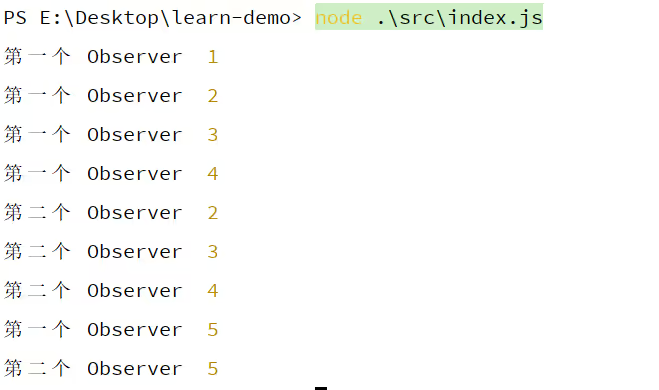RxJS 使用之 Subject
前言 🔗
在写完 pipe 管道之后,写一写 Subject
正文 🔗
什么是 Subject 🔗
什么是 Subject ,官网的解释如下
An RxJS
Subjectis a special type ofObservablethat allows values to be multicasted to many Observers. While plain Observables are unicast (each subscribed Observer owns an independent execution of theObservable), Subjects are multicast.
Subject 是一种特殊 Observable 可观察对象,它允许将值多播给多个观察者。普通的 Observable 是单播的,即每个 subscribe 的观察者都拥有独立的上下文,而 Subject 是多播的
在写《 RxJS 的一些使用及简单理解》的时候,提到过 Observable 的上下文是隔离的
import { Observable } from "rxjs";
const observable = new Observable((subscriber) => {
subscriber.next(Math.random());
subscriber.complete();
});
observable.subscribe((val) => console.log(val));
observable.subscribe((val) => console.log(val));上面的代码会输出不同的值,即每调用一次 subscribe ,都会执行一次传入 Observable 的函数,来生成一个新的上下文
如果使用了 Subject ,那么两次 subscribe 的结果将会一样
import { Subject } from "rxjs";
const subject = new Subject();
subject.subscribe((val) => console.log(val));
subject.subscribe((val) => console.log(val));
subject.next(Math.random());效果如下:
是不是感觉很熟悉,很像 EventEmitter 在注册一个事件?
完全可以看作在注册一个具名的事件, next 就像 emit ,而 subscribe 就像 on
对于每个 Subject,它都维护了一个 Observer 队列,每当调用 subscribe 时把传入的 Observer 加入到队列中,当产生了新的值时,会遍历这个队列,将值发送给每个 Observer
PS:这里要注意,调用 Subject 的 subscribe 并不会和普通的 Observable (通过 new Observable 产生的)对象调用 subscribe 一样,执行传入 Observable 回调( Subject 的构造函数无需传入函数)生成一个新的上下文
这里可能会有疑问:你这个 Subject 怎么还有 next 方法,它不是可观察对象吗?
没错,Subject 是一个可观察对象( Observable ),同时也是一个观察者( Observer )
换句话说, Subject 不仅可以被其他可观察对象订阅,也可以订阅其他的观察者
Subject 有什么用 🔗
经过上面的分析,我们知道了 Subject 的核心能力就是可以把单播的 Observable 转成多播的 Observable
不过我们很难去想象实际的使用场景,所以我去扒了以下 ant-design 的 angular 版本,找到了比较优雅的应用
使用 Subject 来统一 unsubscribe 已 subscribe 的流 🔗
我们知道,当 Observable 被 subscribe 之后,会返回一个 Subscription ,调用它的 unsubscribe 可以执行预先定义的函数,一般用于释放一些资源或者结束定时器等
基于此,我们很容易写出下面这样的代码
import { Component, OnDestroy, OnInit } from '@angular/core';
import { Observable, Subscription } from 'rxjs';
@Component({
selector: '.test',
template: `<div></div>`,
})
export class TestComponent implements OnInit, OnDestroy {
subscription1 = Subscription.EMPTY;
subscription2 = Subscription.EMPTY;
observable1;
observable2;
constructor() {
this.observable1 = new Observable((subscriber) => {
let index = 0;
const timer = setInterval(() => {
subscriber.next(index++);
}, 1000);
return () => {
clearInterval(timer);
};
});
this.observable2 = new Observable((subscriber) => {
let index = 0;
const timer = setInterval(() => {
subscriber.next(index++);
}, 1000);
return () => {
clearInterval(timer);
};
});
}
ngOnInit() {
this.subscription1 = this.observable1.subscribe((val) => console.log(val));
this.subscription2 = this.observable2.subscribe((val) => console.log(val));
}
ngOnDestroy() {
this.subscription1.unsubscribe();
this.subscription2.unsubscribe();
}
}看起来好像没什么问题,但是如果此时不是两个,而是 20 个 Observable 需要释放呢
写 20 个 Subscription 变量,然后去依次调用 unsubscribe ,有点憨憨
这时候我们就可以使用 Subject 以及 pipe 来简化代码
import { Component, OnDestroy, OnInit } from '@angular/core';
import { Observable, Subject, Subscription, takeUntil } from 'rxjs';
@Component({
selector: '.test',
template: `<div></div>`,
})
export class TestComponent implements OnInit, OnDestroy {
observable1;
observable2;
destory$ = new Subject<void>();
constructor() {
this.observable1 = new Observable((subscriber) => {
let index = 0;
const timer = setInterval(() => {
subscriber.next(index++);
}, 1000);
return () => {
clearInterval(timer);
};
});
this.observable2 = new Observable((subscriber) => {
let index = 0;
const timer = setInterval(() => {
subscriber.next(index++);
}, 1000);
return () => {
clearInterval(timer);
};
});
}
ngOnInit() {
this.observable1
.pipe(takeUntil(this.destory$))
.subscribe((val) => console.log(val));
this.observable2
.pipe(takeUntil(this.destory$))
.subscribe((val) => console.log(val));
}
ngOnDestroy() {
this.destory$.next();
this.destory$.complete();
}
}这里使用了 takeUntil 这个管道,这个管道的作用就是在传入的流发出值时,结束源流的订阅(调用 complete )
可以用官网的一张图来解释 takeUntil
不过这似乎和多播特性无关,只是使用了 Subject 作为 Observer 的特性(可以调用 next 发出值)
模拟 EventBus 事件总线 🔗
可以创建一个 Service ,内部使用 Subject 来模拟 EventBus
import { Injectable, OnDestroy } from '@angular/core';
import { Subject, Subscription, takeUntil } from 'rxjs';
@Injectable({
providedIn: 'root',
})
export class TestService implements OnDestroy {
eventMap: Record<string, Subject<any[]>> = {};
destroy$ = new Subject<void>();
on<T extends any[]>(
eventName: string,
callback: (...args: T) => void
): Subscription {
if (this.eventMap[eventName] === undefined) {
this.eventMap[eventName] = new Subject<any[]>();
}
const subject = this.eventMap[eventName];
return subject
.pipe(takeUntil(this.destroy$))
.subscribe((args) => callback(...(args as T)));
}
emit<T extends any[]>(eventName: string, ...args: T): void {
if (this.eventMap[eventName] === undefined) {
return;
}
this.eventMap[eventName].next(args);
if (this.eventMap['*'] === undefined) {
return;
}
this.eventMap['*'].next([...args, eventName]);
}
ngOnDestroy() {
this.destroy$.next();
this.destroy$.complete();
}
}和 mitt 库的区别就是没有了 off 函数,而是使用 Subscription 的 unsubscribe 方法来取消监听
几种 Subject 子类 🔗
在官方的实现中,提供了几种 Subject 的子类供我们使用,每种子类 Subject 都有各自的特性
BehaviorSubject 🔗
特征:能够向订阅的 Observer 立即发送“最近”的一个值
import { BehaviorSubject } from "rxjs";
// 构造函数可以传入一个初始值
const subject = new BehaviorSubject(0);
subject.subscribe((val) => console.log("第一个 Observer ", val)); // 立即收到值 0
subject.next(1); // 第一个 Observer 打印 1
subject.next(2); // 第一个 Observer 打印 2
subject.subscribe((val) => console.log("第二个 Observer ", val)); // 立即收到值 2上面的输出如下:
注意,如果不向 BehaviorSubject 的构造函数传入默认的初始值,那么第一个 Observer 会打印 undefined,也就是默认的初始值被置为了 undefined
import { BehaviorSubject } from "rxjs";
const subject = new BehaviorSubject();
subject.subscribe((val) => console.log("第一个 Observer ", val)); // 立即收到值 undefinedReplaySubject 🔗
特征:能够向订阅的 Observer 立即发送“最近”的一些在限制范围内的值
BehaviorSubject 可以理解为一个特殊的 ReplaySubject , ReplaySubject 可以通过指定 bufferSize 来获取“最近”的一些值
import { ReplaySubject } from "rxjs";
const subject = new ReplaySubject(3);
subject.subscribe((val) => console.log("第一个 Observer ", val)); // 不会输出任何东西
subject.next(1); //第一个 Observer 输出 1
subject.next(2); //第一个 Observer 输出 2
subject.next(3); //第一个 Observer 输出 3
subject.next(4); //第一个 Observer 输出 4
subject.subscribe((val) => console.log("第二个 Observer ", val)); // 第二个 Observer 立即输出 2,3,4
subject.next(5) // 两个 Observer 都输出 5上面的输出如下:
除了限定 bufferSize ,还可以通过第二个参数指定 windowTime 来进一步限定个数
即在 subscribe 之后,查找往前 windowTime 内,最大 bufferSize 个数的值,然后按顺序发送给 Observer
import { ReplaySubject } from "rxjs";
const subject = new ReplaySubject(3, 500);
setTimeout(() => {
subject.next(1);
}, 200);
setTimeout(() => {
subject.next(2);
}, 400);
setTimeout(() => {
subject.next(3);
}, 600);
setTimeout(() => {
// 输出 2,3
subject.subscribe((val) => console.log(val));
}, 800);上面的输出如下:
为什么输出 2 3 ,而不是 1 2 3 呢
因为我们在 800ms 时 subscribe 了,这时往前找 500ms 内的值,即 300ms 之后发送的值,而 1 是 200ms 发送的值,所以不会发送给 Observer
简而言之,bufferSize 和 windowTime 共同限制给 Observer 发送值的数量
如果这 bufferSize 个值正好都是 windowTime 内发出的,那么皆大欢喜,全丢给 Observer 即可
如果某些值不在 windowTime 内发出(早于 windowTime ),那么就舍弃这部分值,把在 windowTime 内的值丢给 Observer 即可
AsyncSubject 🔗
特征:只取最后一个值,在 Subject 完成之后(调用 complete )
import { AsyncSubject } from "rxjs";
const subject = new AsyncSubject();
subject.next(1);
subject.next(2);
subject.subscribe((val) => console.log(val));
subject.complete(); // 输出 2效果如下:
AsyncSubject 很像普通的 Observable 配合 last 管道
import { last, Observable } from "rxjs";
const observable = new Observable((subscriber) => {
subscriber.next(1);
subscriber.next(2);
subscriber.next(3);
subscriber.complete();
});
observable.pipe(last()).subscribe((val) => console.log(val)); // 输出 3




